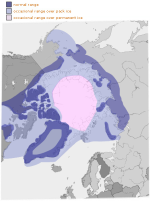- Joined
- Feb 24, 2013
- Messages
- 35,033
- Reaction score
- 19,492
- Gender
- Undisclosed
- Political Leaning
- Conservative
LOL It is not like you homes thermostat, it controls the entire Earth
You still don't get it. Polar bears are marine animals and their habitat is the ice floating in the sea. Humans are not "encroaching" on that habitat they are destroying it by burning millions of tons of fossil fuel and warming the climate. That is what is driving them to the garbage dumps.
Sooo.. "marine animals" like whales?
Note how much of the Polar Bear habitat is not water:

If you manage to read the map properly you will see that...
1) Polar bear NORMAL range is ALL LAND
2) Polar Bear OCCAISIONAL range is on Sea Ice.
Here is another article that you would likely only read the headline, make no meaningful connections beyond what you are told to make, and miss the whole point:

Newly documented population of polar bears in Southeast Greenland sheds light on the species’ future in a warming Arctic
A new population of polar bears documented on the southeast coast of Greenland use glacier ice to survive despite limited access to sea ice. This small, genetically distinct group of polar bears could...
www.washington.edu
The story attempts to connect itself to this manufactured plight of polar bears but the actual takeaway is:
1) Pretty hard to make definitive ruling that the population of the polar bears is shrinking when they are still finding polar bear populations... (see earlier argument about the trouble with using regional populations to determine population count)
2) This particular polar bear population is doing just fine living like every other population of arctic bears...
You really need to stop this nonsense....

